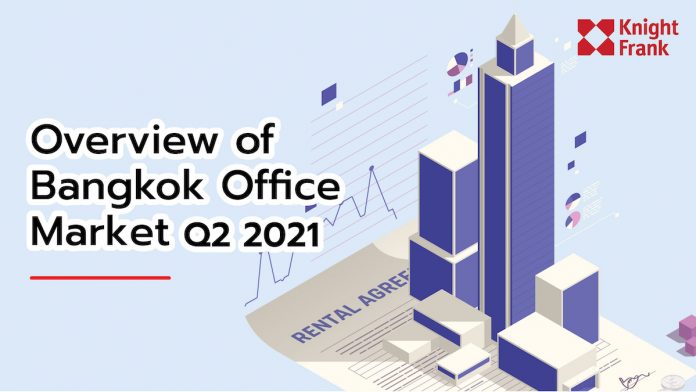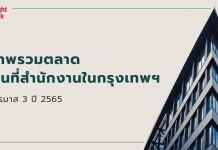Mr. Panya Jenkitvathanalert, Executive Director and Head of Office Agency, Knight Frank Thailand said ”COVID-19 continued to present challenges for both the Thai economy and the Bangkok office market in Q2. Companies extended working from home policies to varying levels – International companies to a greater degree than Thai ones. Most firms are still reluctant to move forward with relocation plans given the uncertain business conditions and unclear vaccination timeline. Nevertheless, there is still significant market movement to be found, mostly driven by companies in the E-Commerce, logistics, technology, and healthcare sectors, which continue to grow at a rapid pace and take up more space. Landlords that are quick to reposition their properties and leasing strategy stand to benefit while others that do not falter.”

Economic Overview
The Bank of Thailand forecasted a 1.8% expansion for the Thai economy in 2021, a lower growth rate than the 3% estimate made in Q1. The economy will then pick up in the following year as it is projected to expand by 3.9% in 2022.
The BOT revised its GDP growth rate estimate downward due to the more prolonged and severe third wave of COVID-19 that affected domestic spending and limited the number of foreign tourists visiting the country. Meanwhile, growth in 2022 will be underpinned by sustained government support and domestic herd immunity likely to be attained within H1 2022. These factors are expected to facilitate a gradual resumption in economic activities and increase foreign tourist admissions. Merchandise export value is expected to expand by 17.3% in 2021 following stronger-than-expected results in Q1.
However, exports of services would continue to contract and slowly recover. Foreign tourist figures were revised down to 7 million in 2021 and 10 million in 2022 following the latest wave, which prompted some countries to maintain international travel restrictions. Private consumption would gradually recover in the latter half of this year despite being restrained in the first half as additional government relief and stimulus measures are rolled out. Progress in vaccine distribution would also contribute to improved consumer confidence, leading to spending resurgence in the tourism and services sector. Private investment recovery would be sustained, expanding by 7% in 2021 and 6 percent the following year. Although private investment in H1 was subdued, it should pick up in H2 because of strong export growth and gradual improvement in private consumption.
The Business Sentiment Index (BSI) in June was at 46.5, below the 50-threshold. This implies that business confidence has declined because a significant number of respondents stated that their business sentiment this month is lower than in the previous. The confidence of respondents in the manufacturing sector was eroded, with weak domestic demand, rising steel prices, and the protracted shipping container shortage the primary causes of concern. Similarly, respondents in the passenger transportation sector remained pessimistic following the prolonged and escalating COVID-19 outbreak. The 3-month expected BSI was recorded at 49.6. The expected BSI for the construction, hotels and restaurants sectors was consistently below the 50-threshold since the beginning of this year.

Supply
Total supply of office space in Bangkok increased by 106,500 sq m to reach 5.53 million sq m in Q2 2021, representing a 2% growth rate from the previous quarter. Three new buildings were completed, adding 22,500 sq m to the CBD and 84,000 sq m to non-CBD areas. Meanwhile, no stock was withdrawn from the market.


Future Supply
In the second half of 2021, it is projected that another 175,800 sq m of office space will enter the market as 9 new projects are completed. Around 60% of the anticipated new supply will be in the CBD. Over the past 5 years, around 157,000 sq m of new supply was added each year. In comparison, if launches in Q3 2021 to 2026 do proceed as planned, the Bangkok office market supply will grow by 1.67 million square meters in total or by an average of 302,000 sq m per year (excluding withdrawals). Developers remained unfazed by the market slowdown over the past year and have continued to both deliver projects relatively on schedule and announce future additions to the pipeline. Construction progress at some sites have been slowed following recent government restrictions to curb the spread of COVID-19. However, it is anticipated that these measures will not have a significant long-term impact on projection completion dates unless the pandemic worsens considerably, and more restrictive actions are taken. Even with COVID-19-related construction delays and a rise in withdrawals of obsolete stock that could counteract the effects of a probable oversupply in the market, the market imbalance will not likely be corrected in the short term.

Demand
On a cautiously optimistic note, leasing activity continued to show signs of recovery as take up increased by 61% Q-o-Q to 78,000 sq m. This level is above the 10-year average of 67,000 sq m of take up per quarter. Meanwhile, 57,100 sq m of space was vacated, representing a 4th consecutive quarter of improvement. As take up exceeded the amount of space vacated, a net absorption of 21,000 sq m was recorded, marking the first quarter in which net absorption was positive since Q1 2020. However, it can be highlighted that supply grew by 106,500 sq m over the same period, indicating that the gap between supply and demand continued to widen. In addition, 36,300 sq m or around 47% of take up was due to leases generated by new and refurbished properties, revealing that demand was highly concentrated within a few properties and that most office properties still experienced contraction in occupied space. As net absorption was positive, total occupied space increased by 0.5% Q-o-Q to 4.59 million sq m. More space that is partially or fully fitted out continued to be leased out as capital expenditure budgets for tenants remained limited. Although most of the fit out are existing builds left by vacating tenants, a few landlords have successfully attracted tenants via built-to-suit fit outs or tenant improvement allowances.
In addition, coworking operators became even more prominent demand drivers, having entered into profit-sharing agreements with landlords, enabling the operators to considerably reduce upfront costs required to set up the space. Previously, the model was largely untested and did not garner much interest from most landlords; They preferred to remain “traditional” space providers, citing lack of expertise or desire to invest CAPEX to operate co-working space. Now, a greater number of them have signed off on profit-sharing co-working space projects, opting to take on some investment risk in exchange for potential future income rather than allow the space to remain vacant.

The market occupancy rate dropped by 1.2% points to 83%. This is the lowest occupancy rate experienced by the market over the past decade and represents the 9th consecutive quarter in which the rate declined. In comparison, the 10-year average occupancy rate stands at 90%. All grade segments continued to underperform their long-term averages. Interestingly, while the occupancy rate dropped by 1.5% points for grade B and 1.8% points for grade C, it increased by 0.3% points for grade A. The drop in asking rents for grade A properties may have attract some tenants by creating greater affordability for higher quality spaces.
The occupancy rate for the entire CBD fell by 0.7% points Q-o-Q. However, the occupancy rate increased for the Ploenchit – Chidlom – Wireless and Nana – Asoke – Promphong sub-markets, rising by 1.2% points and 0.2% points respectively. Meanwhile, the occupancy rate in non-CBD regions decreased by 1.9% points. Only Phaholyothin – Viphavadi experienced some growth, with the occupancy rate increasing by 0.9%.

Rental Rates
The average asking rent was held almost constant from Q1, dropping by just 1 baht to 791 baht per sq m per month. Most landlords continued to maintain their asking rents but provided greater room for negotiation. In some leasing deals, the effective rate is up to 30% lower than the asking rent. The average asking rent is now down 1.3% yearly, far below the positive 3.8% average annual growth rate experienced over the past decade. As previously mentioned, the average asking rent declined for grade A properties, falling by 0.8% Q-o-Q. Meanwhile, it increased by 0.6% for grade B and 1.3% for grade C.


The average asking rent fell by 0.6% Q-o-Q for CBD properties. Only Thonglor – Ekkamai – Phra Khanong experienced positive rental growth as it is the only submarket where the average rate is up on both a quarterly and annual basis. Meanwhile, the average asking rent for non-CBD properties increased by 1.5% over the same period. This is mostly due to the 2 new completions which are priced above their average sub-market rate, as indicated by the 2.7% Q-o-Q rental increase recorded in Petchburi – Rama IX – Ratchada.

Review & Outlook
In Q2 2021, we saw some signs of demand recovery in the Bangkok office market, albeit mostly from the strong leasing performance of new properties rather than market-wide improvement. If the market continues to experience positive net absorption throughout the year, it will make a strong demand recovery trend more definitive. This is highly dependent on whether vaccination targets are achieved, and the spread of COVID-19 virus is controlled within this year.
Nevertheless, the Bangkok Office market continued to move away from its cyclical peak as occupancies fell and asking rents declined for most sub-markets. The tenants’ market that we saw emerge in Q1 2021 was strengthened as the gap between supply and demand continued to grow. Even if demand returns to pre-COVID levels, tenants will likely still have strong bargaining power given the relatively large supply pipeline, especially during the upcoming 3 years.
Previously, we projected that landlords would yield to the downward pressure and drop their asking rate to secure tenancies. While this prediction was proven accurate, it is possible that a “price floor” will emerge. This means that if landlords observe that reducing the asking rent has limited effectiveness on improving their property’s leasing performance, they may opt for a different strategy entirely. If this is a market-wide trend, then we may see flat asking rental growth rates rather than negative ones. For many properties at which the asking rent have been kept constant, landlords are responding to the market downturn by offering both rent and non-monetary incentives such as greater flexibility in negotiation and lease terms, and longer rent-free periods, leading to lower net effective rents. If supply continues to outpace demand, negative annual effective rental growth rates over the next 3 years are likely to continue.
The remote working trend became even more pronounced following the 3rd wave of COVID-19 with new, more contagious variants and the latest government mandated 2-week lockdown. It is estimated that 70% to 80% of employees in companies that require office space are now working from home, an even greater proportion than in the first quarter. Nevertheless, we maintain our stance that most companies that successfully adopted remote working policies will continue to do so, but likely to a limited extent; The future workplace will be defined by a combination of core + flex space and remote working. As a result, we still do not anticipate massive decreases in demand for office space in the medium to long term.
The next few years will present a challenge for office market landlords. No longer are the policies and approaches widespread in a seller’s market relevant given today’s circumstances. However, as demonstrated by the strong leasing performance of some new properties that entered the market in this quarter, there are still opportunities to secure tenancies at office buildings that can be adapted or built to cater to the shifted demand. We already began to see some market participants adapt to the recent changes and implement novel business models such as the profit-sharing partnership with co-working operators. It is clearer now than ever that the office is much more than a physical space designated for work; flexibility, talent retention and experiences related to such factors as the environment, safety, and wellbeing matter as well.















